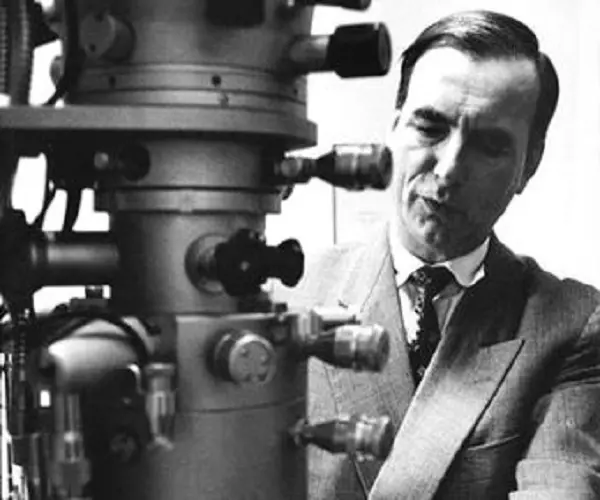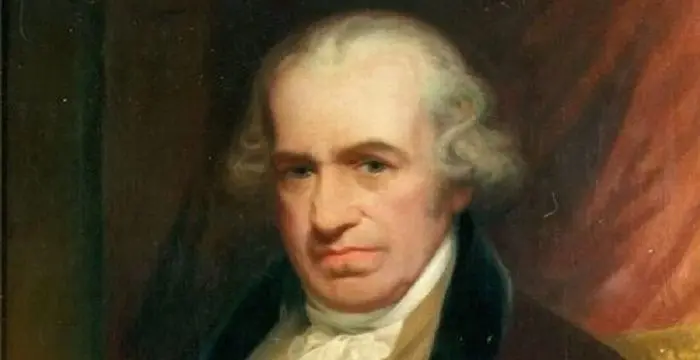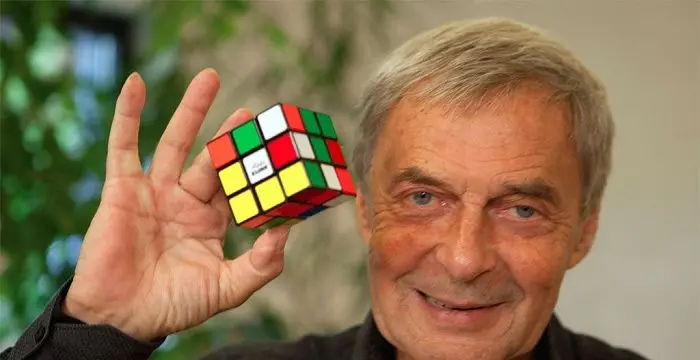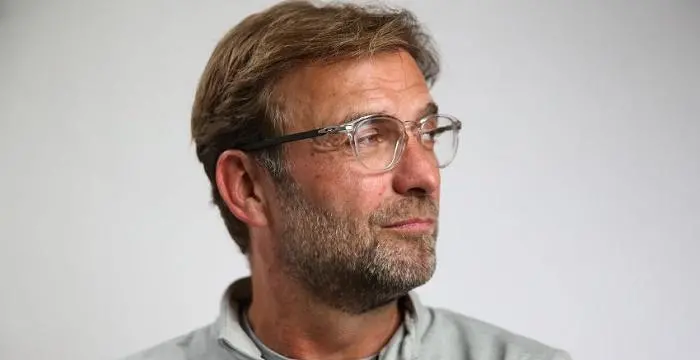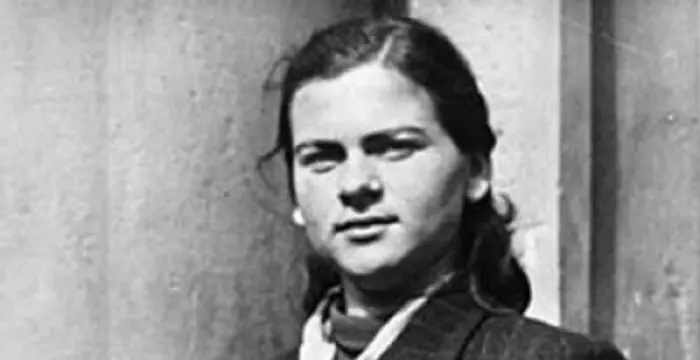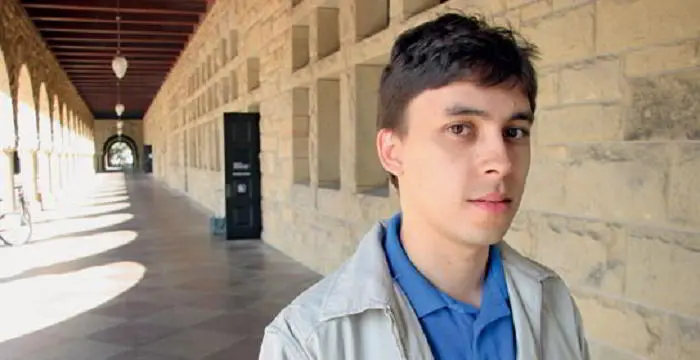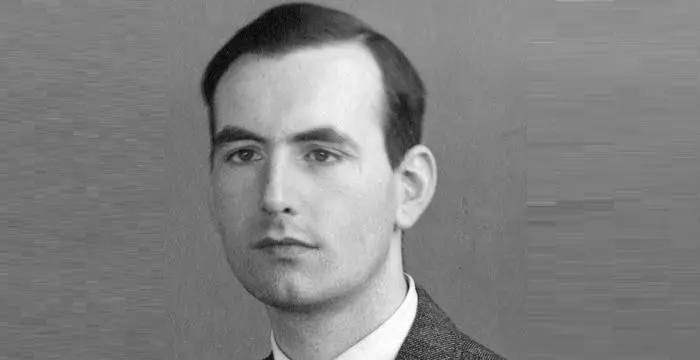
Ernst Ruska - Inventor of Electron Microscope, Family and Childhood
Ernst Ruska's Personal Details
Ernst Ruska was a German physicist who invented the electron microscope
| Information | Detail |
|---|---|
| Birthday | December 25, 1906 |
| Died on | May 27, 1988 |
| Nationality | German |
| Famous | Inventors & Discoverers, Physicists, Inventor of Electron Microscope |
| Siblings | Helmut Ruska |
| Known as | Руска, Эрнст Август |
| Universities |
|
| Discoveries / Inventions |
|
| Birth Place | Heidelberg |
| Gender | Male |
| Sun Sign | Capricorn |
| Born in | Heidelberg |
| Famous as | Inventor of Electron Microscope |
| Died at Age | 81 |
Ernst Ruska's photo
Who is Ernst Ruska?
German physicist and academician Ernst Ruska is best known for the invention of the electron microscope, one of the most important inventions of the 20th century. A pioneer in the field of electron optics, he was awarded one half of the Nobel Prize in Physics in 1986 in recognition of his contribution to the field. The son of a professor, he developed a keen interest in technology while still a young student and studied at the Technical University of Munich before moving to the Technical University of Berlin. It was as a student that he began the research that eventually led to the development of the electron microscope. He completed his PhD the same year he built his first electron microscope, and continued his research in the field. He also collaborated with his brother, a medical doctor who developed the use of the electron microscope for medical and biological applications. Besides being a noted physicist, he was also a highly respected professor of electron optics and microscopy and was active in this role till his retirement. As a prominent physicist he received numerous awards and honors for his work including Duddell Medal and Prize, Robert Koch Prize, and the Nobel Prize in physics. Throughout his academic career, he contributed to a number of books, publications, and scientific papers in the area of electron optics.
// Famous Inventors & Discoverers
Nikola Tesla
Nikola Tesla was a Serbian-American inventor, best known for his development of alternating current electrical systems. This biography of Nikola Tesla provides detailed information about his childhood, life, achievements, works & timeline.
Thomas Newcomen
Thomas Newcomen was a British inventor who developed the world’s first steam engine. Browse through this biography to learn in details about his life, career, works and timeline.
Erno Rubik
The famous inventor and educationist, Erno Rubik is known world-wide for his invention the ‘Rubik’s Cube’. To know more about the childhood, profile, timeline and career of this famous architect-inventor read on.
Childhood & Early Life
Ernst August Friedrich Ruska was born on December 25, 1906, in Heidelberg, German Empire, to Professor Julius Ruska and his wife Elisbeth. He was the fifth of the seven children of his parents.
He received his early education from grammar school in Heidelberg and after graduating from grammar school, he studied electronics at the Technical College in Munich from 1925 to 1927. Thereafter, he enrolled at the Technical University of Berlin and was certified as an electrical engineer in 1931.
After receiving his undergraduate degree in electrical engineering in 1931, he went on to pursue his doctorate from the Berlin Institute of Technology. He completed his Ph.D. in 1933. His dissertation was on electron optics and electron microscopy.
Career
His first completed scientific work was the mathematical and experimental proof of “Busch's theory” of the effect of the magnetic field of a coil of wire through which an electric current is passed. This was in 1929 and led to the development of the ‘polschuh lens’ which was later used in all magnetic high-resolution electron microscopes.
Under the tutelage of Dr. Max Knoll, Ruska created an early version of the electron microscope in 1931. Prior to his invention, the field of optics suffered from the inability to study objects whose wavelengths were smaller than those of visible light.
He improved the microscope further and built a better model in 1933. This version was ten times more powerful than contemporary optical microscopes. In this microscope, he passed electrons through a very thin slice of the object under study that was then deflected onto photographic film or onto a fluorescent screen, producing an image that could be greatly magnified.
During his study at the Technical College of Berlin, he was involved with high voltage and vacuum technology at the Institute of High Voltage. He was employed by Fernseh Corporation in Berlin and worked on the development of a high performance cathode ray oscilloscope.
He joined ‘Siemens-Reiniger-Werke AG’ in 1937 as an electrical engineer and concurrently became a lecturer at the Technical University of Berlin. At Siemens, he developed the first customized electron microscope, Siemens Super Microscope, in 1939.
On his encouragement, Siemens set up a visiting institute for research work to be carried out using electron microscopy, in 1940. The laboratory was headed by Helmut Ruska, his brother who was a medical doctor. Working with German and foreign scientists, the institute published over 400 papers by the end of 1944.
The “Institute of Electron Optics” in Berlin-Siemensstadt, that had been the victim of a bombing, was reconstituted by him and his colleagues in 1945. This led to a major production of electron microscopes by 1949.
Between August 1947 and December 1948, he worked as a faculty member of medicine and biology at the “German Academy of Sciences” in Berlin-Buch. He was the Head of Department at the “Fritz Haber Institute” of the Max Planck Society in Berlin-Dahlem in 1949. He worked at these institutions to further the development of the electron microscope.
He became a member of the ‘Max Planck Society’ in 1954 and gave up his position at Siemens the following year. He was made the director of the Society's ‘Institute of Electron Microscopy’ in 1957.
In 1959, he accepted an invitation by the Technical University of Berlin to become a professor of electron optics and electron microscopy, a position he held until his retirement in 1974.
The electron microscope and its numerous practical applications in the field of medicine, neurology, bacteriology, biology, chemistry and physics ensured him the “Nobel Prize in Physics” in 1986, 55 years after it was invented.
Major Works
Optical microscopes, until 1931, were unable to process wavelengths shorter than the wavelength of visible light. It was established in the 1920s that electrons have waves that are shorter than those of light. Ruska applied this principle to invent the ‘electron microscope’. This invention enabled the study of objects which could be magnified greatly and studied.
Awards & Achievements
His first major recognition was the ‘Senckenberg Prize’ of the University of Frankfurt am Main. It was given to him in 1939 in honor of his contributions and body of work.
Ernst Ruska was awarded the Albert Lasker Award for Basic Medical Research’ in 1960. Fifteen years later, he received the Duddell Medal and Institute of Physics Prize in London in 1975.
In 1986, 55 years after he invented the ‘electron microscope’, the Nobel committee honored him with the ‘Nobel Prize in Physics’ for his body of work in electron optics. He received half of the prize with the other half being shared by Dr. Gerd Binnig and Dr. Heinrich Rohrer for their design of the “Scanning Tunneling Microscope”.
Personal Life & Legacy
Ernst Ruska married Irmela Ruth Geigis in 1937. Together they had three children; two sons, and a daughter.
He passed away on May 27, 1988, in West Berlin, Germany, at the age of 81.
Trivia
His Nobel Prize win came 55 years after the invention of his most celebrated work, the electron microscope. He was astonished when he received it and stated that he could have expected the win 40 years ago.
// Famous Physicists
Henry Cavendish
Henry Cavendish was a theoretical chemist and physicist, renowned for discovery of hydrogen and calculation of the mass of earth. To know more about his childhood, profile, timeline and career read on
Walter Kohn
Nobel Laureate Walter Kohn was an Austrian-born American theoretical chemist and physicist. Check out this biography to know about his childhood, life, achievements, works & timeline.
Nikola Tesla
Nikola Tesla was a Serbian-American inventor, best known for his development of alternating current electrical systems. This biography of Nikola Tesla provides detailed information about his childhood, life, achievements, works & timeline.
Ernst Ruska's awards
| Year | Name | Award |
|---|---|---|
Other | ||
| 0 | 1986 - Nobel Prize in Physics | |
| 0 | 1960 - Albert Lasker Award for Basic Medical Research | |
| 0 | 1970 - Paul Ehrlich and Ludwig Darmstaedter Prize | |
Ernst Ruska biography timelines
- // 25th Dec 1906Ernst August Friedrich Ruska was born on December 25, 1906, in Heidelberg, German Empire, to Professor Julius Ruska and his wife Elisbeth. He was the fifth of the seven children of his parents.
- // 1929His first completed scientific work was the mathematical and experimental proof of “Busch's theory” of the effect of the magnetic field of a coil of wire through which an electric current is passed. This was in 1929 and led to the development of the ‘polschuh lens’ which was later used in all magnetic high-resolution electron microscopes.
- // 1931 To 1933After receiving his undergraduate degree in electrical engineering in 1931, he went on to pursue his doctorate from the Berlin Institute of Technology. He completed his Ph.D. in 1933. His dissertation was on electron optics and electron microscopy.
- // 1931Under the tutelage of Dr. Max Knoll, Ruska created an early version of the electron microscope in 1931. Prior to his invention, the field of optics suffered from the inability to study objects whose wavelengths were smaller than those of visible light.
- // 1931Optical microscopes, until 1931, were unable to process wavelengths shorter than the wavelength of visible light. It was established in the 1920s that electrons have waves that are shorter than those of light. Ruska applied this principle to invent the ‘electron microscope’. This invention enabled the study of objects which could be magnified greatly and studied.
- // 1933He improved the microscope further and built a better model in 1933. This version was ten times more powerful than contemporary optical microscopes. In this microscope, he passed electrons through a very thin slice of the object under study that was then deflected onto photographic film or onto a fluorescent screen, producing an image that could be greatly magnified.
- // 1937 To 1939He joined ‘Siemens-Reiniger-Werke AG’ in 1937 as an electrical engineer and concurrently became a lecturer at the Technical University of Berlin. At Siemens, he developed the first customized electron microscope, Siemens Super Microscope, in 1939.
- // 1937Ernst Ruska married Irmela Ruth Geigis in 1937. Together they had three children; two sons, and a daughter.
- // 1939His first major recognition was the ‘Senckenberg Prize’ of the University of Frankfurt am Main. It was given to him in 1939 in honor of his contributions and body of work.
- // 1940 To 1944On his encouragement, Siemens set up a visiting institute for research work to be carried out using electron microscopy, in 1940. The laboratory was headed by Helmut Ruska, his brother who was a medical doctor. Working with German and foreign scientists, the institute published over 400 papers by the end of 1944.
- // 1945 To 1949The “Institute of Electron Optics” in Berlin-Siemensstadt, that had been the victim of a bombing, was reconstituted by him and his colleagues in 1945. This led to a major production of electron microscopes by 1949.
- // 1954 To 1957He became a member of the ‘Max Planck Society’ in 1954 and gave up his position at Siemens the following year. He was made the director of the Society's ‘Institute of Electron Microscopy’ in 1957.
- // 1959 To 1974In 1959, he accepted an invitation by the Technical University of Berlin to become a professor of electron optics and electron microscopy, a position he held until his retirement in 1974.
- // 1960 To 1975Ernst Ruska was awarded the Albert Lasker Award for Basic Medical Research’ in 1960. Fifteen years later, he received the Duddell Medal and Institute of Physics Prize in London in 1975.
- // 1986The electron microscope and its numerous practical applications in the field of medicine, neurology, bacteriology, biology, chemistry and physics ensured him the “Nobel Prize in Physics” in 1986, 55 years after it was invented.
- // 1986In 1986, 55 years after he invented the ‘electron microscope’, the Nobel committee honored him with the ‘Nobel Prize in Physics’ for his body of work in electron optics. He received half of the prize with the other half being shared by Dr. Gerd Binnig and Dr. Heinrich Rohrer for their design of the “Scanning Tunneling Microscope”.
- // 27th May 1988He passed away on May 27, 1988, in West Berlin, Germany, at the age of 81.
// Famous German peoples
Jordan Carver
Jordan Carver is a famous German model. Let’s take a close look at her personal life, including her age, career, net worth, achievements and some fun facts.
Jürgen Klopp
Jürgen Klopp is a German football manager, and a former professional football player. Check out this biography to know more about his childhood, family, personal life, etc.
Irma Grese
Irma Grese was a notorious German Nazi concentration camp guard during the Second World War. This biography profiles her childhood, life, horrifying acts, death and other facts.
Juliane Koepcke
Juliane Koepcke is a German-Peruvian biologist, who was the lone survivor among the 92 passengers and crew of the ill-fated LANSA Flight 508 that crashed in the Peruvian rainforest on 24 December 1971. Know more about her life in this biography.
Jawed Karim
Jawed Karim is a German-American internet entrepreneur, technologist and co-founder of the video-sharing website, YouTube. Check out this biography to know about his childhood, family, personal life, achievements, age, etc.
Charles Bukowski
Charles Bukowski was a German-born American novelist, short story writer and poet. With this biography, learn in details about his childhood, life, works, career and timeline
Ernst Ruska's FAQ
What is Ernst Ruska birthday?
Ernst Ruska was born at 1906-12-25
When was Ernst Ruska died?
Ernst Ruska was died at 1988-05-27
Where was Ernst Ruska died?
Ernst Ruska was died in West Berlin
Which age was Ernst Ruska died?
Ernst Ruska was died at age 81
Where is Ernst Ruska's birth place?
Ernst Ruska was born in Heidelberg
What is Ernst Ruska nationalities?
Ernst Ruska's nationalities is German
Who is Ernst Ruska siblings?
Ernst Ruska's siblings is Helmut Ruska
What was Ernst Ruska universities?
Ernst Ruska studied at Technical University of Berlin, Technische Universität München
What is Ernst Ruska's inventions/discoveries?
Electron Microscope was invented (or discovered) by Ernst Ruska
What is Ernst Ruska's sun sign?
Ernst Ruska is Capricorn
How famous is Ernst Ruska?
Ernst Ruska is famouse as Inventor of Electron Microscope
